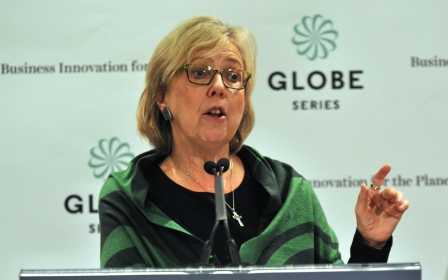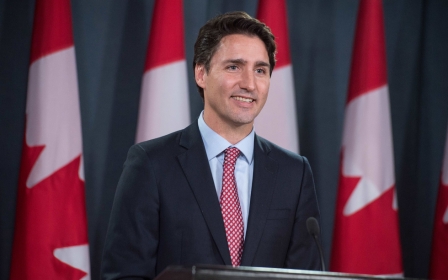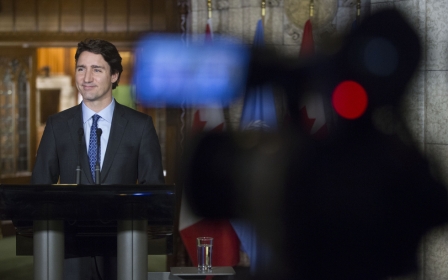Canadian police kill IS sympathiser after he sets off bomb

Canadian police said they thwarted a "potential terrorist threat" after shooting dead an alleged Islamic State (IS) group sympathiser, who set off an explosive device.
Media reports said 24-year-old Aaron Driver was shot dead on Wednesday night during a police raid on a home in Strathroy, Ontario, 220km southwest of Toronto.
Police say he had already detonated one device inside a taxi at rush hour, injuring the driver, and was carrying a second homemade explosive device.
A relative told Canadian public broadcaster CBC that police informed the family that the man was shot dead after detonating the first explosive device.
They told the family they had to shoot Driver because he had a second device, which he was planning to detonate, CBC said.
Driver's father said he knew he son was "lost" but did not know "how far he had gone".
The Royal Canadian Mounted Police said there had been "credible information of a potential terrorist threat" and that there had been a "race against time," as the suspect was preparing for an immediate attack with a homemade bomb.
It is unclear where Driver was travelling and whether it was to his intended target, police said. They added that there was no reason to believe he had any accomplices.
Mike Cabana, RCMP deputy commissioner, said the FBI alerted Canadian authorities early on Wednesday about an "unknown individual that was clearly in the final stages of planning an attack using a homemade explosive device" in Canada.
"Obviously it was a race against time," Mr Cabana said. "How quickly this was all established is actually a testament to the level of collaboration that exists between law enforcement agencies."
Based on the information received, police believed an attack was possible "within the following 72 hours" in an "urban centre".
'A lone wolf'
Driver was described in media reports as a Muslim convert with a troubled childhood who became radicalised on the internet.
"It was like he turned out the lights and put a 'Do Not Disturb' sign on the door," his father told CBC in interviews last year.
"When he was living at home, he was very secretive; a lone wolf. He didn't bring friends over, never talked about where he was going and what he was doing," the father said.
Driver came to the attention of Canadian authorities in 2014 after posting messages on Twitter in support of IS, and justifying a Muslim convert's killing of a sentry at Canada's national war memorial in Ottawa during a 22 October, 2014 attack that spilled into the nearby parliament building.
Driver told the CBC in an interview last year that a country which "goes to war with another country or another people or another community" should be prepared for attacks like Ottawa.
"And when it does happen they shouldn't act surprised. They had it coming to them; they deserved it."
He was arrested in June 2015 and released under court supervision.
Driver was ordered to undergo counselling from a religious leader, wear a monitoring bracelet and stay off the internet. Those restrictions were gradually loosened and were due to expire this month.
According to a court order, there were "reasonable grounds to fear that he may participate, contribute directly or indirectly in the activity of a terrorist group," the Canadian Press news agency reported.
Ties with militant groups
The RCMP, however, revealed that Driver had been in "fairly constant contact" with violent militants around the world.
They included two members of the Islamic State group, a British youth arrested for his involvement in a terror plot targeting Australia, and Elton Simpson - one of two Americans who launched an attack on a Texas exhibition of caricatures of the Prophet Mohammed last year.
Investigators searching Driver's home in 2015 found a recipe for homemade bombs on his computer.
In a video released by the RCMP on Thursday, Driver warned Canadians: "You have Muslim blood on your hands and for this we will have your blood."
Unfolding probe
Canadian police said an investigation was under way as the matter "continues to unfold". No other details from officials were immediately available.
"Canadians can be confident that whenever credible information is obtained about a potential terrorist threat... police and security agencies take the appropriate steps to ensure the safety of this country and its citizens," Public Safety Minister Ralph Goodale said.
"These agencies conducted themselves effectively in the circumstances that developed today."
Goodale said Canada's terrorism threat level remains at "medium," a ranking which it has maintained since the October 2014 Ottawa attack.
The Conservative government responded by passing a bill that gives police and Canada's spy agency sweeping powers to thwart attacks and prevent Canadian youth from flying overseas to join IS militants in Syria.
Canada joined the US-led coalition against IS in September 2014.
New MEE newsletter: Jerusalem Dispatch
Sign up to get the latest insights and analysis on Israel-Palestine, alongside Turkey Unpacked and other MEE newsletters
Middle East Eye delivers independent and unrivalled coverage and analysis of the Middle East, North Africa and beyond. To learn more about republishing this content and the associated fees, please fill out this form. More about MEE can be found here.




